Changlin Li
Refer to the report for detailed contributions
CoNav: Collaborative Cross-Modal Reasoning for Embodied Navigation
May 22, 2025Abstract:Embodied navigation demands comprehensive scene understanding and precise spatial reasoning. While image-text models excel at interpreting pixel-level color and lighting cues, 3D-text models capture volumetric structure and spatial relationships. However, unified fusion approaches that jointly fuse 2D images, 3D point clouds, and textual instructions face challenges in limited availability of triple-modality data and difficulty resolving conflicting beliefs among modalities. In this work, we introduce CoNav, a collaborative cross-modal reasoning framework where a pretrained 3D-text model explicitly guides an image-text navigation agent by providing structured spatial-semantic knowledge to resolve ambiguities during navigation. Specifically, we introduce Cross-Modal Belief Alignment, which operationalizes this cross-modal guidance by simply sharing textual hypotheses from the 3D-text model to the navigation agent. Through lightweight fine-tuning on a small 2D-3D-text corpus, the navigation agent learns to integrate visual cues with spatial-semantic knowledge derived from the 3D-text model, enabling effective reasoning in embodied navigation. CoNav achieves significant improvements on four standard embodied navigation benchmarks (R2R, CVDN, REVERIE, SOON) and two spatial reasoning benchmarks (ScanQA, SQA3D). Moreover, under close navigation Success Rate, CoNav often generates shorter paths compared to other methods (as measured by SPL), showcasing the potential and challenges of fusing data from different modalities in embodied navigation. Project Page: https://oceanhao.github.io/CoNav/
HunyuanVideo: A Systematic Framework For Large Video Generative Models
Dec 03, 2024



Abstract:Recent advancements in video generation have significantly impacted daily life for both individuals and industries. However, the leading video generation models remain closed-source, resulting in a notable performance gap between industry capabilities and those available to the public. In this report, we introduce HunyuanVideo, an innovative open-source video foundation model that demonstrates performance in video generation comparable to, or even surpassing, that of leading closed-source models. HunyuanVideo encompasses a comprehensive framework that integrates several key elements, including data curation, advanced architectural design, progressive model scaling and training, and an efficient infrastructure tailored for large-scale model training and inference. As a result, we successfully trained a video generative model with over 13 billion parameters, making it the largest among all open-source models. We conducted extensive experiments and implemented a series of targeted designs to ensure high visual quality, motion dynamics, text-video alignment, and advanced filming techniques. According to evaluations by professionals, HunyuanVideo outperforms previous state-of-the-art models, including Runway Gen-3, Luma 1.6, and three top-performing Chinese video generative models. By releasing the code for the foundation model and its applications, we aim to bridge the gap between closed-source and open-source communities. This initiative will empower individuals within the community to experiment with their ideas, fostering a more dynamic and vibrant video generation ecosystem. The code is publicly available at https://github.com/Tencent/HunyuanVideo.
DiffuTraj: A Stochastic Vessel Trajectory Prediction Approach via Guided Diffusion Process
Oct 12, 2024Abstract:Maritime vessel maneuvers, characterized by their inherent complexity and indeterminacy, requires vessel trajectory prediction system capable of modeling the multi-modality nature of future motion states. Conventional stochastic trajectory prediction methods utilize latent variables to represent the multi-modality of vessel motion, however, tends to overlook the complexity and dynamics inherent in maritime behavior. In contrast, we explicitly simulate the transition of vessel motion from uncertainty towards a state of certainty, effectively handling future indeterminacy in dynamic scenes. In this paper, we present a novel framework (\textit{DiffuTraj}) to conceptualize the trajectory prediction task as a guided reverse process of motion pattern uncertainty diffusion, in which we progressively remove uncertainty from maritime regions to delineate the intended trajectory. Specifically, we encode the previous states of the target vessel, vessel-vessel interactions, and the environment context as guiding factors for trajectory generation. Subsequently, we devise a transformer-based conditional denoiser to capture spatio-temporal dependencies, enabling the generation of trajectories better aligned for particular maritime environment. Comprehensive experiments on vessel trajectory prediction benchmarks demonstrate the superiority of our method.
Ada-adapter:Fast Few-shot Style Personlization of Diffusion Model with Pre-trained Image Encoder
Jul 08, 2024



Abstract:Fine-tuning advanced diffusion models for high-quality image stylization usually requires large training datasets and substantial computational resources, hindering their practical applicability. We propose Ada-Adapter, a novel framework for few-shot style personalization of diffusion models. Ada-Adapter leverages off-the-shelf diffusion models and pre-trained image feature encoders to learn a compact style representation from a limited set of source images. Our method enables efficient zero-shot style transfer utilizing a single reference image. Furthermore, with a small number of source images (three to five are sufficient) and a few minutes of fine-tuning, our method can capture intricate style details and conceptual characteristics, generating high-fidelity stylized images that align well with the provided text prompts. We demonstrate the effectiveness of our approach on various artistic styles, including flat art, 3D rendering, and logo design. Our experimental results show that Ada-Adapter outperforms existing zero-shot and few-shot stylization methods in terms of output quality, diversity, and training efficiency.
Perception-Oriented Video Frame Interpolation via Asymmetric Blending
Apr 10, 2024



Abstract:Previous methods for Video Frame Interpolation (VFI) have encountered challenges, notably the manifestation of blur and ghosting effects. These issues can be traced back to two pivotal factors: unavoidable motion errors and misalignment in supervision. In practice, motion estimates often prove to be error-prone, resulting in misaligned features. Furthermore, the reconstruction loss tends to bring blurry results, particularly in misaligned regions. To mitigate these challenges, we propose a new paradigm called PerVFI (Perception-oriented Video Frame Interpolation). Our approach incorporates an Asymmetric Synergistic Blending module (ASB) that utilizes features from both sides to synergistically blend intermediate features. One reference frame emphasizes primary content, while the other contributes complementary information. To impose a stringent constraint on the blending process, we introduce a self-learned sparse quasi-binary mask which effectively mitigates ghosting and blur artifacts in the output. Additionally, we employ a normalizing flow-based generator and utilize the negative log-likelihood loss to learn the conditional distribution of the output, which further facilitates the generation of clear and fine details. Experimental results validate the superiority of PerVFI, demonstrating significant improvements in perceptual quality compared to existing methods. Codes are available at \url{https://github.com/mulns/PerVFI}
DNA Family: Boosting Weight-Sharing NAS with Block-Wise Supervisions
Mar 02, 2024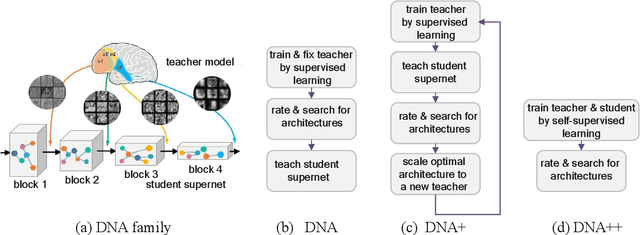
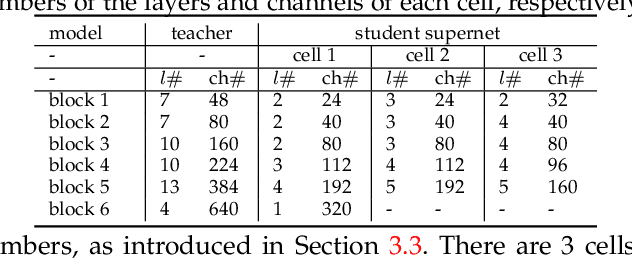
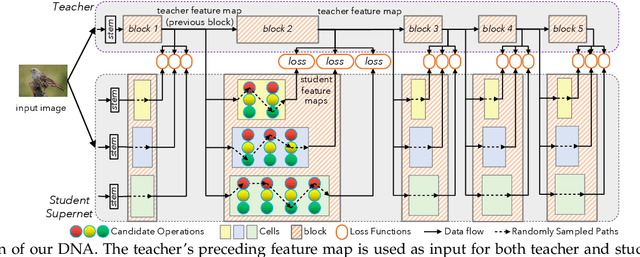
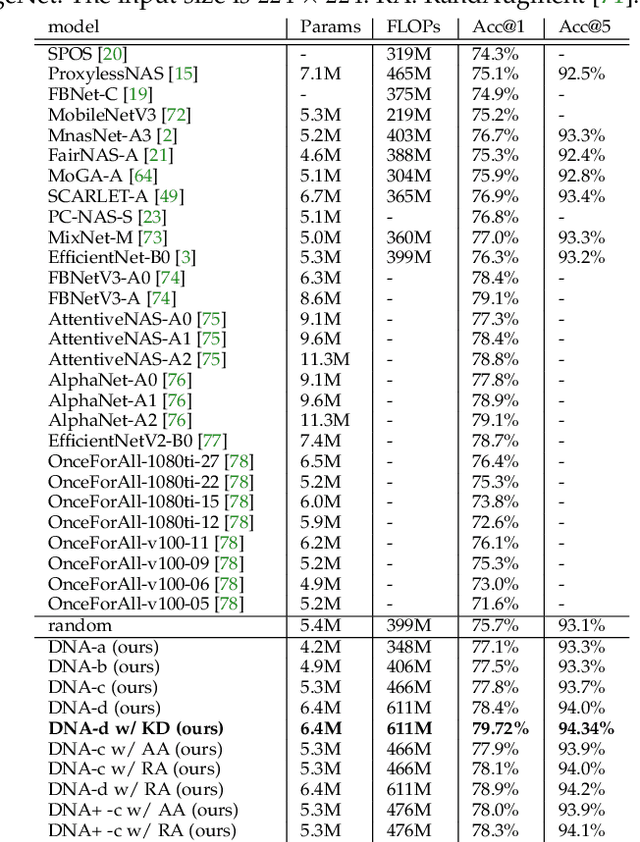
Abstract:Neural Architecture Search (NAS), aiming at automatically designing neural architectures by machines, has been considered a key step toward automatic machine learning. One notable NAS branch is the weight-sharing NAS, which significantly improves search efficiency and allows NAS algorithms to run on ordinary computers. Despite receiving high expectations, this category of methods suffers from low search effectiveness. By employing a generalization boundedness tool, we demonstrate that the devil behind this drawback is the untrustworthy architecture rating with the oversized search space of the possible architectures. Addressing this problem, we modularize a large search space into blocks with small search spaces and develop a family of models with the distilling neural architecture (DNA) techniques. These proposed models, namely a DNA family, are capable of resolving multiple dilemmas of the weight-sharing NAS, such as scalability, efficiency, and multi-modal compatibility. Our proposed DNA models can rate all architecture candidates, as opposed to previous works that can only access a subsearch space using heuristic algorithms. Moreover, under a certain computational complexity constraint, our method can seek architectures with different depths and widths. Extensive experimental evaluations show that our models achieve state-of-the-art top-1 accuracy of 78.9% and 83.6% on ImageNet for a mobile convolutional network and a small vision transformer, respectively. Additionally, we provide in-depth empirical analysis and insights into neural architecture ratings. Codes available: \url{https://github.com/changlin31/DNA}.
No Token Left Behind: Efficient Vision Transformer via Dynamic Token Idling
Oct 09, 2023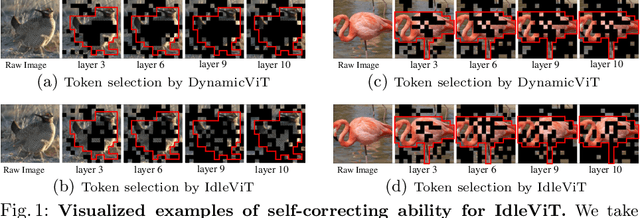
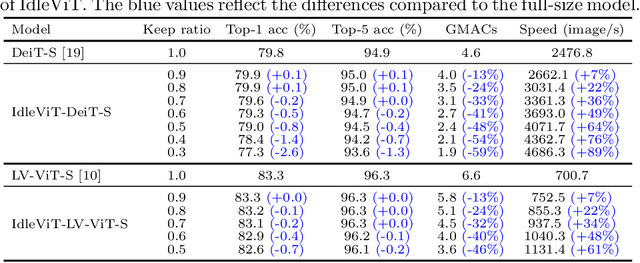


Abstract:Vision Transformers (ViTs) have demonstrated outstanding performance in computer vision tasks, yet their high computational complexity prevents their deployment in computing resource-constrained environments. Various token pruning techniques have been introduced to alleviate the high computational burden of ViTs by dynamically dropping image tokens. However, some undesirable pruning at early stages may result in permanent loss of image information in subsequent layers, consequently hindering model performance. To address this problem, we propose IdleViT, a dynamic token-idle-based method that achieves an excellent trade-off between performance and efficiency. Specifically, in each layer, IdleViT selects a subset of the image tokens to participate in computations while keeping the rest of the tokens idle and directly passing them to this layer's output. By allowing the idle tokens to be re-selected in the following layers, IdleViT mitigates the negative impact of improper pruning in the early stages. Furthermore, inspired by the normalized graph cut, we devise a token cut loss on the attention map as regularization to improve IdleViT's token selection ability. Our method is simple yet effective and can be extended to pyramid ViTs since no token is completely dropped. Extensive experimental results on various ViT architectures have shown that IdleViT can diminish the complexity of pretrained ViTs by up to 33\% with no more than 0.2\% accuracy decrease on ImageNet, after finetuning for only 30 epochs. Notably, when the keep ratio is 0.5, IdleViT outperforms the state-of-the-art EViT on DeiT-S by 0.5\% higher accuracy and even faster inference speed. The source code is available in the supplementary material.
Aspect-oriented Opinion Alignment Network for Aspect-Based Sentiment Classification
Aug 22, 2023Abstract:Aspect-based sentiment classification is a crucial problem in fine-grained sentiment analysis, which aims to predict the sentiment polarity of the given aspect according to its context. Previous works have made remarkable progress in leveraging attention mechanism to extract opinion words for different aspects. However, a persistent challenge is the effective management of semantic mismatches, which stem from attention mechanisms that fall short in adequately aligning opinions words with their corresponding aspect in multi-aspect sentences. To address this issue, we propose a novel Aspect-oriented Opinion Alignment Network (AOAN) to capture the contextual association between opinion words and the corresponding aspect. Specifically, we first introduce a neighboring span enhanced module which highlights various compositions of neighboring words and given aspects. In addition, we design a multi-perspective attention mechanism that align relevant opinion information with respect to the given aspect. Extensive experiments on three benchmark datasets demonstrate that our model achieves state-of-the-art results. The source code is available at https://github.com/AONE-NLP/ABSA-AOAN.
GrowCLIP: Data-aware Automatic Model Growing for Large-scale Contrastive Language-Image Pre-training
Aug 22, 2023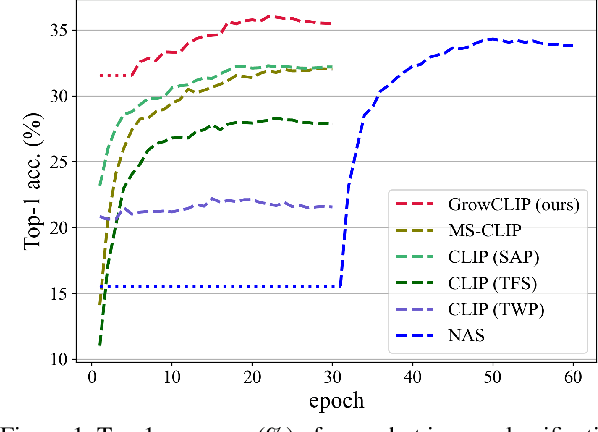

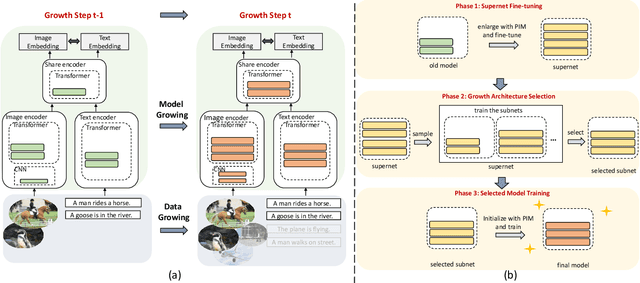

Abstract:Cross-modal pre-training has shown impressive performance on a wide range of downstream tasks, benefiting from massive image-text pairs collected from the Internet. In practice, online data are growing constantly, highlighting the importance of the ability of pre-trained model to learn from data that is continuously growing. Existing works on cross-modal pre-training mainly focus on training a network with fixed architecture. However, it is impractical to limit the model capacity when considering the continuously growing nature of pre-training data in real-world applications. On the other hand, it is important to utilize the knowledge in the current model to obtain efficient training and better performance. To address the above issues, in this paper, we propose GrowCLIP, a data-driven automatic model growing algorithm for contrastive language-image pre-training with continuous image-text pairs as input. Specially, we adopt a dynamic growth space and seek out the optimal architecture at each growth step to adapt to online learning scenarios. And the shared encoder is proposed in our growth space to enhance the degree of cross-modal fusion. Besides, we explore the effect of growth in different dimensions, which could provide future references for the design of cross-modal model architecture. Finally, we employ parameter inheriting with momentum (PIM) to maintain the previous knowledge and address the issue of the local minimum dilemma. Compared with the existing methods, GrowCLIP improves 2.3% average top-1 accuracy on zero-shot image classification of 9 downstream tasks. As for zero-shot image retrieval, GrowCLIP can improve 1.2% for top-1 image-to-text recall on Flickr30K dataset.
MixReorg: Cross-Modal Mixed Patch Reorganization is a Good Mask Learner for Open-World Semantic Segmentation
Aug 09, 2023



Abstract:Recently, semantic segmentation models trained with image-level text supervision have shown promising results in challenging open-world scenarios. However, these models still face difficulties in learning fine-grained semantic alignment at the pixel level and predicting accurate object masks. To address this issue, we propose MixReorg, a novel and straightforward pre-training paradigm for semantic segmentation that enhances a model's ability to reorganize patches mixed across images, exploring both local visual relevance and global semantic coherence. Our approach involves generating fine-grained patch-text pairs data by mixing image patches while preserving the correspondence between patches and text. The model is then trained to minimize the segmentation loss of the mixed images and the two contrastive losses of the original and restored features. With MixReorg as a mask learner, conventional text-supervised semantic segmentation models can achieve highly generalizable pixel-semantic alignment ability, which is crucial for open-world segmentation. After training with large-scale image-text data, MixReorg models can be applied directly to segment visual objects of arbitrary categories, without the need for further fine-tuning. Our proposed framework demonstrates strong performance on popular zero-shot semantic segmentation benchmarks, outperforming GroupViT by significant margins of 5.0%, 6.2%, 2.5%, and 3.4% mIoU on PASCAL VOC2012, PASCAL Context, MS COCO, and ADE20K, respectively.
 Add to Chrome
Add to Chrome Add to Firefox
Add to Firefox Add to Edge
Add to Edge